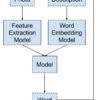Caption generation is the challenging artificial intelligence problem of generating a human-readable textual description given a photograph. It requires both image understanding from the domain of computer vision and a language model from the field of natural language processing. It is important to consider and test multiple ways to frame a given predictive modeling problem […]










